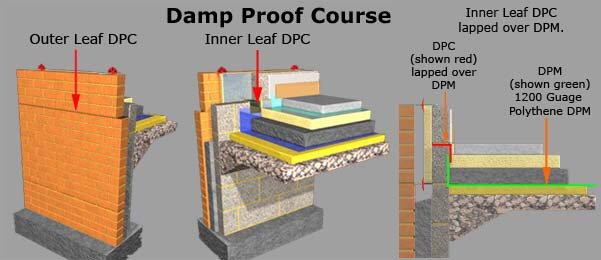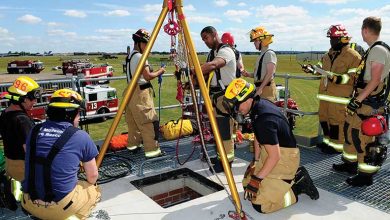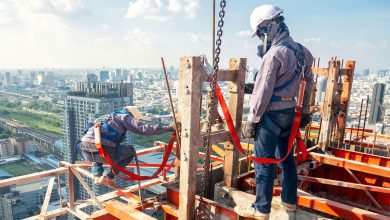Damp-Proof Course: The Definitive Guide

A damp-proof course is an important protective device if you want to keep your house dry. A damp-proof course works by forming an impermeable waterproof barrier that prevents water from rising into a home, preventing costly and hazardous problems that can arise because of dampness.
A damp-proof course is typically installed in modern houses, although older structures may not have ever had one. A damp-proof practitioner can assist you in identifying and solving problems before they cause damage by providing a moisture barrier.
The experts at Danford, Brewer & Ives have prepared a comprehensive guide to damp-proof courses to help you appreciate the significance of damp proofing your home.
What Is a Damp-Proof Course?
A damp-proof course is a type of waterproofing that protects a building from the hazards of moisture, dampness, and excessive water. A properly built damp-proof course forms an effective waterproof barrier against moisture penetration through the masonry and brickwork and then into the house.
In most cases, a damp-proof course is simply above ground level and is designed to keep rising damp out. There are numerous types of damp-proof courses, including one in which a wetting agent is injected into the ground floor masonry.
If no damp-proof course is constructed, excessive groundwater and moisture can rise through the bricks, causing damage to your home. This damp problem may lead to structural and safety concerns if left unchecked.
What Is a Damp Proof-Course and How Do They Work?
There are several different types of damp-proof courses, and they all function in somewhat diverse ways.
Damp-proof courses must be installed at least 150mm above ground level, which is a legal requirement that ensures the waterproof barrier is built above groundwater. A damp-proof course is generally set in the masonry or brickwork of a house’s lowest floor to protect against rising damp, which comes into a building from the earth below.
Damp-proof courses, also known as damp-proofing membranes, work by chemically impregnating the wall. They are most effective when utilized in conjunction with other damp-proofing techniques, such as a damp-proof membrane. The following are some of the most popular types of damp-proof courses that may be put in your house:
Chemical Damp-Proof Course
A chemical damp-proof course is injected into the masonry and brickwork of a property, and it’s most effective when set 150mm above ground level. It’s made up of a specialist damp-proofing lotion that creates an impermeable waterproof barrier as it sets in the bricks.
The chemical damp-proof course is inserted into the holes drilled straight into the wall at the required height and then injected.
Mortar Damp-Proof Course
A damp-proof course is also inserted directly into holes drilled in a wall, and it must be injected 150mm above ground level to work effectively.
Mortar damp-proof courses are a chemically enhanced type of mortar that can fill any holes in masonry and brickwork, eliminating the risk of rising damp moving through the walls. The mortar, once injected, provides a waterproof barrier by filling in these gaps and preventing any potential rise damp from getting through the walls.
Non-Chemical Damp-Proof Course
Non-chemical damp-proof courses include Electro Osmotic damp-proof courses, which are the most common. This differs from a chemical damp-proof course in that it uses metal wiring to generate an electric charge instead of chemicals.
This electric charge, rather than forming a physical, waterproof barrier, changes the polarity of the wall itself. This means that rising damp is repelled downward rather than being drawn upward through the brickwork. In comparison to a quicker chemical injection, this system isn’t as popular since it’s more difficult and time-consuming to set up.
Damp-Proof Membrane
While a damp-proof course is useful in preventing rising dampness, it’s most effective when used in conjunction with other damp-proofing techniques. The most popular way to prevent moisture and wetness is to install a damp-proof membrane, which creates a physical impermeable barrier against both dampness and moisture.
Waterproofing consists of several different methods, the most basic being a damp-proof membrane. A damp-proof membrane must be at least 1,200 gauges and positioned so that the layers overlap and create an effective barrier.
Why Do I Need a Damp-Proof Course in My Home?
A damp-proof course’s primary aim is to keep water from damaging your home and causing costly or even deadly repairs. Excess moisture, as well as water, are the origin of dampness, which is why a damp-proof course is designed to provide a waterproof barrier against it.
There are various sorts of dampness that may be found in a house, such as condensation, rising dampness, and penetrating dampness. The primary goal of a damp-proof course is to prevent rising dampness, which happens when the water rises through the brickwork via capillary action and moves vertically through bricks and mortar.
If dampness is not addressed, it might eventually harm the foundations of your home. Other undesirable side effects include fungus and mould, both of which can cause respiratory problems and significant health and safety concerns for everyone who resides there.
One cause of rising dampness is a lack of a damp-proof course, although it can also be caused by large leaks, floods, or other broken infrastructure such as drains or pipes. As a result, it’s critical to make sure your home is completely waterproofed with an effective damp-proof course in place to prevent excessive moisture and water from getting inside.
How Do I Know If My House Has a Damp-Proof Course?
If you don’t already have a damp-proof course in place at your home, now is the time to install one. Since the late 19th century, it has been a legal obligation for a property to have a damp-proof course constructed. This implies that contemporary houses will already have one in place, and it’s very probable that older buildings did as well.
However, there’s a possibility that a Victorian-era home may never have been improved with a modern damp-proof course. If this is the case, it’s critical to install a contemporary damp-proof course as soon as possible and to maintain any previous damp-proofing measures.
If your house has a damp-proof course, it will eventually decay. If this occurs, you may experience damp problems in your property. The ground may shift, walls might cave in, and brickwork and masonry might fall after the damp-proof course is put in place. Checks on a regular basis and a professional damp and timber survey can help you detect any concerns with the damp-proof course in your home or home to purchase.
Signs of dampness can be found on both internal and external walls, but the most apparent signal is almost certainly a pungent musty odour that drifts through the home. If you see salty tidemarks on the walls, this is an indication of rising dampness, which we’ve previously said typically occurs because of a faulty damp-proof course.
A damp-proof course failure isn’t the only source of moisture, and various types of damp can lead to a variety of issues. If you’re concerned about any problems related to dampness, it’s critical to hire an expert to determine the source and solution.
How Do You Fix a Damp-Proof Course?
A damaged damp-proof course may be repaired or entirely replaced. The first step is to contact a professional for a damp survey if you detect any of the major indications of wetness in your property.
The professional will determine the source of the damp and the type of damp before suggesting the best solution. If a broken or missing damp-proof course is to blame, they will advise on the best sort of damp-proof course to use. Any wet must be removed before the damp-proof course is replaced. The new damp-proof course can either be inserted or installed after it has been dried out. To gain access, any wet may need to be eliminated, or it might as simple as drilling holes into the walls and mixing a moisture-resistant chemical substance.
Contact DBI for More Information About Damp-Proof Courses
A damp-proof course is necessary if you want to damp proof your home. Danford, Brewer & Ives, a seasoned team of experts who have been providing expert assistance with all your damp-proofing needs since 1820, is ready to assist you. For more information about constructing a damp-proof course or to schedule an initial survey and consultation, contact our staff today.




